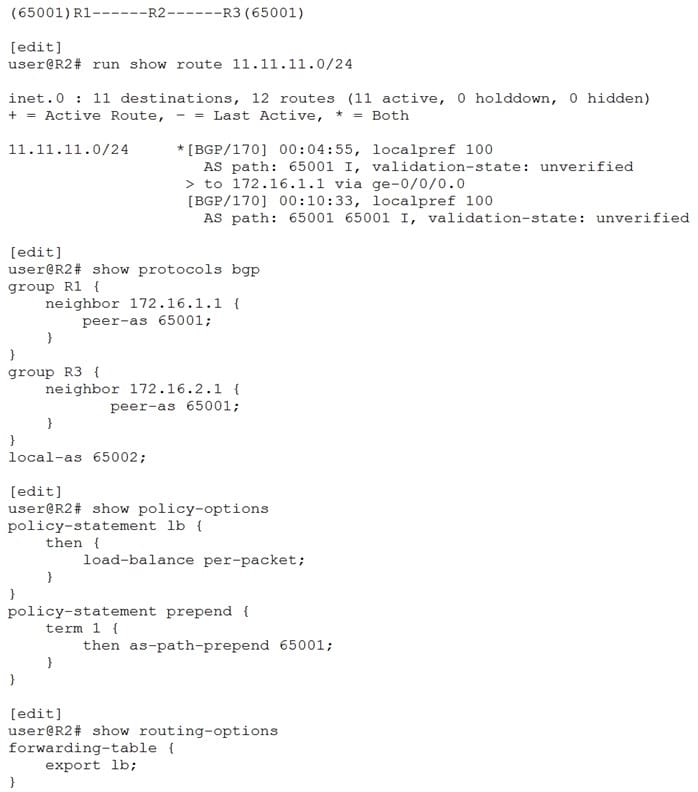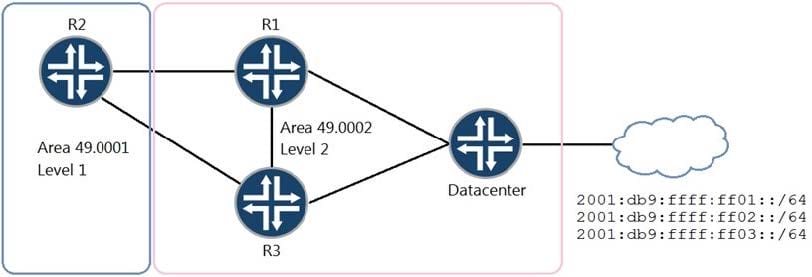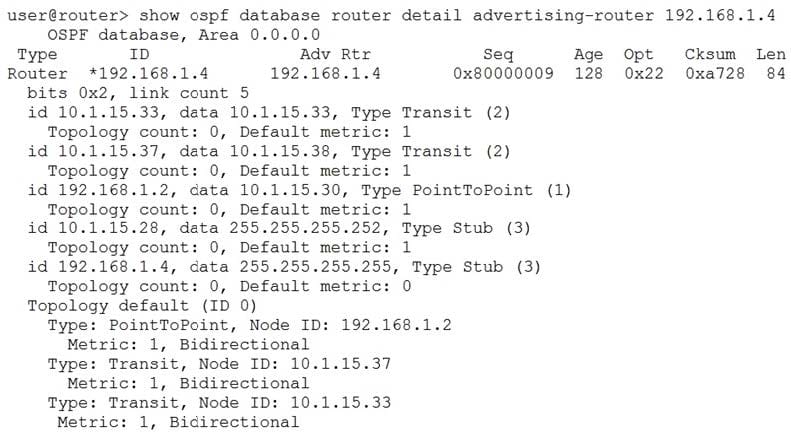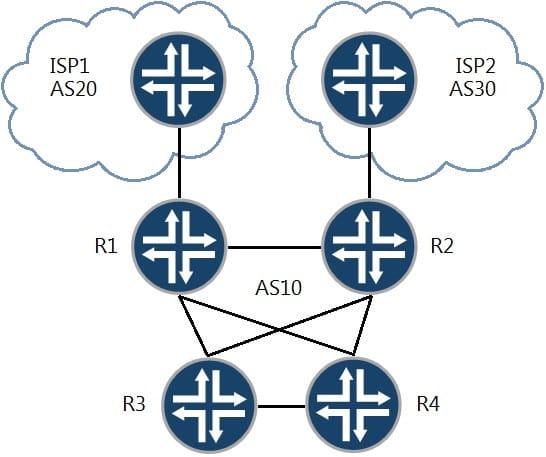JN0-663 Online Practice Questions and Answers
Questions 4

R2 is receiving the same route from R1 and R3. You must ensure that you can load balance traffic for that route.
Referring to the exhibit, which two configuration changes will allow load balancing? (Choose two.)
A. Apply the prepend policy as an import policy under group R1.
B. Configure multipath under the global BGP configuration.
C. Configure multipath under group R1.
D. Apply the prepend policy as an import policy under group R3.
Questions 5

You are provisioning Layer 2 circuits between sites CE1, CE2, and CE3.
Referring to the exhibit, which statement is true?
A. A point-to-multipoint LSP must be created between sites.
B. Each site must have only one VLAN configured to the PE.
C. Site PE1 must have a point-to-multipoint link configured towards the core.
D. Two VLANs must be configured from PE 1 to CE 1.
Questions 6
Which two statements about wide and narrow metrics used in IS-IS are correct? (Choose two.)
A. Wide metrics are enabled with the wide-metrics-only parameter under protocols isis hierarchy.
B. Narrow metrics are enabled by default and use 8 bits in TLVs to send information.
C. Wide metrics are sent by default and use 24 bits in TLVs to send information.
D. Disabling narrow metrics results in external routes being leaked from L1 to L2 areas automatically.
Questions 7

Referring to the exhibit, traffic sent from CE-A2 to PE3 does not loop back to CE-A2 through PE2.
Winch two EVPN functions accomplish this task? (Choose two.)
A. multicast ingress replication
B. aliasing
C. split horizon
D. designated forwarder election
Questions 8

A network designer wants to ensure that traffic from R2 destined for 2001:db9:ffff:ff00::/62 always traverses the R2-R1 link if that link is available.
Referring to the exhibit, which configuration change will satisfy this requirement?

A. Option A
B. Option B
C. Option C
Questions 9

You have an established Layer 3 VPN between two PE devices. You are asked to only send certain routes from PE-1 over the VPN to the remote site while maintaining all the routes on the PE-1 device. You created a policy that matches the specific routes and then tags these routes with the appropriate target community values.
In this scenario, which configuration changes must be made to satisfy the requirement?
A. Configure the export parameter and apply the policy to the my-ext-group BGP group configuration.
B. Configure the vrf-export parameter and apply the policy under the edit routing-instances vpn-a hierarchy.
C. Configure a RIB group and apply the policy as an import policy to routes distributed into the bgp.13vpn.0 routing table.
D. Configure the import parameter and apply the policy to the my-ext-group BGP group configuration.
Questions 10
You are considering different MPLS VPN connectivity options for a new customer deployment. Your customer requires shared LSPs, Layer 2 connectivity, and auto-provisioning.
Which type of VPN satisfies the requirements?
A. BGP Layer 3 VPNs
B. circuit cross-connects
C. LDP Layer 2 circuits
D. BGP Layer 2 VPNs
Questions 11

Referring to the exhibit, which two statements are true? (Choose two.)
A. This router is an ASBR.
B. There are two interfaces marked as passive.
C. There is one interface marked as passive.
D. This router is an ABR.
Questions 12

Referring to the exhibit, you want to make ISP1 your preferred connection for inbound and outbound traffic.
Which two steps will accomplish this task? (Choose two.)
A. Create an export policy setting local-preference 200 and next-hop self and apply it to the IBGP peers on R2.
B. Create an export policy to prepend the ASN on advertised routes and apply it to the EBGP peer on R1.
C. Create an export policy to prepend the ASN on advertised routes and apply it to the EBGP peer on R2.
D. Create an export policy setting local-preference 200 and next-hop self and apply it to the IBGP peers on R1.
Questions 13
You recently deployed CoS-based forwarding in your network, which uses OSPF as its IGP. You notice that the forwarding of traffic has not changed and is not following the path indicated within your configuration.
In this scenario, which statement explains this behavior?
A. The defined policy references IP addresses as the next-hops instead of interface names.
B. Load balancing has not been enabled under [edit forwarding-options].
C. The defined policy references interface names as the next-hops instead of IP addresses.
D. The defined policy has not been applied under [edit class-of-service forwarding-policy].
